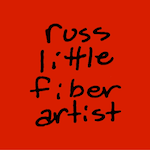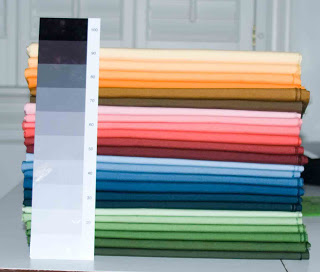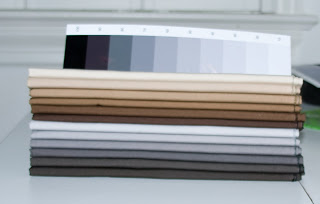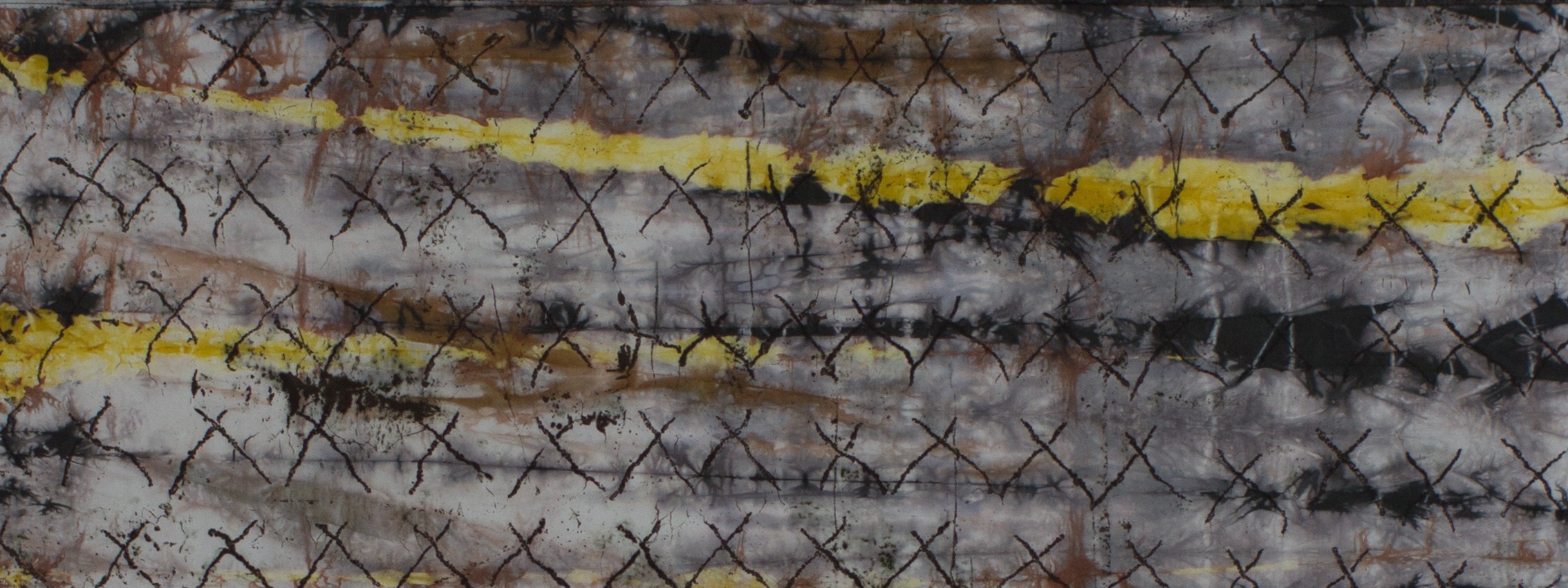
Thoughts & news
Carol Soderlund's "Neutral Territory"--way more than 50 shades of grey
I've just returned from two weeks at the Crow Timber Frame Barn in Ohio for two outstanding workshops, one with Carol Soderlund (carolsoderlund.com) and one with David Hornung (davidhornung.com). I'll write about David's workshop in a future post. This one is all about Carol's workshop, which was titled "Neutral Territory: 50 Shades of Gray + 50 Shades of Brown."
In her "Color Mixing for Dyers" workshop, Carol teaches the basics of full-immersion and low-water immersion dyeing with Procion MX dyes. The tangible products of the class are a head full of knowledge, Carol's stunningly detailed handouts, and THICK binder that her students affectionately refer to as, "The Bible". This reference volume contains thousands of dyed 1-inch square fabric samples (made in class) to document the cubic color model for several combinations of different yellow, red, and blue dye. It's amazing, and I use my notebook almost every time I'm in the dye studio.
So, why all of the description of a workshop that I took 6 years ago? Well, "Neutral Territory" builds on "Color Mixing." Every combination of three pure MX dye primary colors has the potential to create a neutral black, warm black, cool black, etc. The trick is finding the right proportions of yellow, red, and blue. What I'm telling you is that I paid good money to spend 5 days with Carol and 19 other students mixing untold numbers (way more than 50!) of very carefully formulated mixtures of dye searching for good black candidates, then creating 10-step gradations of the best candidates to see if what we thought was black was really neutral or had a hue leaning. And, we only scratched the surface of the 80 families (i.e., possible combinations) of yellows, reds, and blues. It was as much about the investigative method as it was about the end result. That said, I'm now the proud owner of another mighty sample book, which might come to be known as "The Apocrypha".
For me, the culmination of the workshop came late on the 4th day when I washed out some silk samples that I'd just discharged and realized that I'd managed to combine what I learned in this workshop with what I'd previously learned in Carol's "Dyeing to Discharge" and "True Colors" to select a dye combination, mix a black by eye, and create a predictable result that I've been wanting for some time now--a black that grades down to a silver-gray and discharges to near white. I love that feeling that comes when deep study in a subject area produces learning that all begins to overlap and intersect.
I count this workshop as another great week spent with an outstanding teacher and excellent mentor. If you have any serious interest in dyeing, I urge you to seek an opportunity to study with Carol. Rest assured, you'll be a better dyer for having done so.
Getting intimate with MX colors
- I fully acknowledge that this might be a little crazy (in the OCD category).
- I'm only planning to dye the primaries, secondary, and tertiary colors, and I"m only dying a single value of each hue.
- Yes, there will be duplication from one color group to the next. For example, the same yellow will be crossed with multiple reds and blues.
- Produce a reference that shows how the primaries interact.
- Identify primary triads that speak to me and merit further exploration (Soderlund color cube?).
- Learn by doing.
- Develop color palettes different from the one that have become habitual to me.
65+ yards and counting
I'm into my 3rd bolt of cloth and I'm building up a nice stash of solid color yardage for my class in Sept (Nancy Crow). I'm learning a lot from the exercise. If nothing else, I've gotten better about keeping lab records. I'm dyeing all of the solids with a full immersion processe. That means mixing and preparing dye and auxiliaries for about30 minutes then standing in front of a bucket for about an hour and a half. I've come up with a setup that lets me do 3 yards at a time. I manually agitate 2 buckets and let my Wonder Washer tend a 3rd yard (with a few quick checks along the way). What is a Wonder Washer you might ask? Well, basically it's like something straight out of an infomercial. It's a table top washing machine that looks just like an old school diaper pail crossbred with an ice cream maker. If you want to see one in action you might check out this slightly odd video of some straight guy doing his laundry http://www.youtube.com/watch?v=vJ4Nix460h4. Of course I bought the thing so who am I to talk about odd.
Anyway, I'm using the Soderlund method. My first family of colors (bright) was all dyed by overdyeing yellow, red, and blue to match samples from my (her) color book. This was really time consuming and I didn't realize that I should be using a different approach until I'd dyed about 30 yards of cloth various values of yellow. I had no choice but to continue with the overdye method to the bitter end. It was worth the work. I'm really pleased with the result.
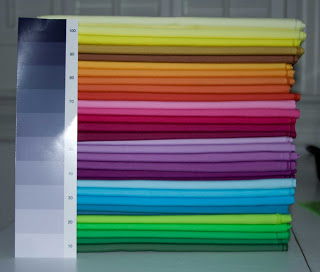
Next I moved on to a more subdued color family (Earth) and switched to a value gradation method. Carol has a nice formula for creating a 10-step value gradation of a single hue from very light to almost black. I wanted a 6-step and didn't want really light or really dark, so I used the basic method, but came up with my own scale (a log10 progression) that's producing very nice results. It's 4 steps of pure color and 2 steps toned with complement.
This Earth family also produces some really excellent browns and blacks. I'd love to dye nothing but this for a while.
I've still got more solids to dye, but I'm also starting to move on to some prints. It's been a long time since I did any printing with the intent to create yardage (i.e., not art cloth). It's a bit confining not to be able to work big and do whatever I want. The repeating pattern, stripe, grid thing doesn't feel right. I want to discharge and go back into all of the pieces below, but I need to resist for now. I might still do something. I need to let these stew for now. I will probably supplement the stash with some commercial stripes and plaids (Nancy's request--I'm afraid to know what we're going to do with plaid).
Multiple printings with two values of two different colors.
Mono printing combined with batik. This piece and the one above were both overdyed with the same blue as the last step to help unify them.
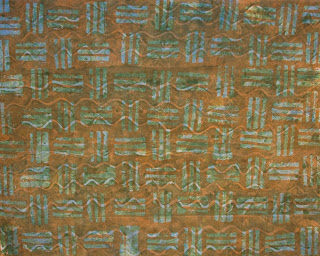
Well, that's all for now. I'll certainly post more before the class (or at least I "plan" to).
